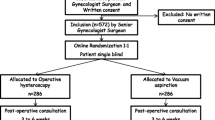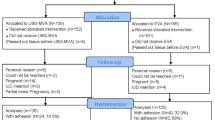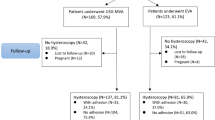Abstract
Vacuum aspiration, either manual or electric, has for many years been the most commonly used method for termination of an early pregnancy. More recently, new medical methods have been developed which for many women are attractive alternatives to the surgical procedure. The compounds mainly used are prostaglandin analogues, methotrexate, and mifepristone in combination with a suitable prostaglandin analogue. However, only the last method has been registered for routine clinical use. The treatment schedule mainly used is mifepristone 200 to 600mg followed 36 to 48 hours later by oral misoprostol 0.4 to 0.6mg in pregnancies up to 49 days and vaginal gemeprost 1.0mg or misoprostol 0.8mg if the treatment period is extended to 63 days of amenorrhoea.
The ability to compare medical and surgical methods is limited by the fact that there are few randomised studies and the definitions of successful outcome (complete abortion), adverse effects and complications vary from one study to the other. Experience with the method used is also important for the outcome. However, it seems adequate to state that the medical method is equally, or almost equally, as effective as vacuum aspiration. Duration of bleeding and amount of blood loss is greater following medical abortion. Also the frequency of uterine pain, vomiting and diarrhoea is higher following medical abortion than following vacuum aspiration. On the other hand, the frequency of major complications such as excessive bleeding, blood transfusion and pelvic infection does not seem to differ between the two procedures. Surgical complications, for example, uterine perforation and cervical tears, are obviously not a risk associated with medical abortion.
Both methods are equally well accepted provided the woman is allowed to choose. It is not possible to state which method is best. Medical termination of early pregnancy will not replace, but is an alternative to, vacuum aspiration and ideally both methods should be available to give the woman a choice.





Similar content being viewed by others
References
Grimes DA, Cates Jr W. Complications from legally induced abortion: a review. Obstet Gynecol Surv 1979; 34: 177–91
Hart G, Macharper T. Clinical aspects of induced abortion in South Australia from 1970–1984. Aust N Z J Obstet Gynaecol 1986; 26: 219–24
Ashok PW, Kidd A, Flett SMM, et al. A randomized comparison of medical abortion and surgical vacuum aspiration at 10–13 weeks gestation. Hum Reprod 2002; 17: 92–8
Philibert D. RU 38486: an original multifaceted antihormone in vivo. In: Agarwall MK, editor. Adrenal Steroid Antagonism. Berlin: Gruyter, 1984: 70–101
Bygdeman M, Swahn ML. Progesterone receptor blockage. Effect on uterine contractility in early pregnancy. Contraception 1985; 32: 45–51
Swahn ML, Bygdeman M. The effect of the antiprogestin RU 486 on uterine contractility and sensitivity to prostaglandin and oxytocin. Br J Obstet Gynaecol 1988; 95: 126–34
Baird DT. Mode of action of medical methods of abortion. JAMWA 2000; 55 (3 Suppl.): 121–6
Zieman M, Fong SK, Benowitz NL, et al. Absorption kinetics of misoprostol with oral or vaginal administration. Obstet Gynecol 1997; 90: 88–92
Gemzell Danielsson K, Marions L, Rodriguez A, et al. Comparison between oral and vaginal administration of misoprostol on uterine contractility. Obstet Gynecol 1999; 93: 275–80
Dimov V, Green K, Bygdeman M, et al. Gas chromatographic-mass spectrometric quantitation of 16,16-dimethyl-trans-Δ2-PGE1. Prostaglandins 1983; 25: 225–35
DeLoia JA, Stewart-Akers AM, Creinin MD. Effect of methotrexate on trophoblast proliferation and local immune response. Hum Reprod 1998; 12: 1063–9
Swahn ML, Bygdeman M. Medical methods to terminate early pregnancy. In: Bygdeman M, editor. Medical induction of abortion. Bailliere Tindall, 1990; 4(2): 293–306
World Health Organisation Task Force on Post-ovulatory Methods of Fertility Regulation. Menstrual regulation by intramuscular injections of 16-phenoxy-tetranor PGE2 methyl sulfonyl amide or vacuum aspiration. A randomized multi-centre study. Br J Obstet Gynaecol 1987; 94: 949–56
Cameron IT, Baird DT. Early pregnancy termination: a comparison between vacuum aspiration and medical abortion using prostaglandin (16.16 dimethyl-trans-2-PGE1 methyl ester) or the antiprogestogen RU 486. Br J Obstet Gynaecol 1988; 95: 271–7
Norman JE, Joo Thong K, Baird DT. Uterine contractility and induction of abortion in early pregnancy by misoprostol and mifepristone. Lancet 1991 Nov 16; 338: 1233–6
Carbonell JLL, Varela L, Velasco A. Early abortion with 800 μg of misoprostol by the vaginal route. Contraception 1999; 59: 219–25
Ngai SW, Tang OS, Chan YM, et al. Vaginal misoprostole alone for medical abortion up to 9 weeks of gestation; efficacy and acceptability. Hum Reprod 2000; 15(5): 1159–62
Creinin MD, Pymar HC. Medical abortion alternative to mifepristone. JAMWA 2000; 55(3): 127–32
Carbonell JLL, Varela L, Velasco A, et al. Oral methotrexate and vaginal misoprostol for early abortion. Contraception 1998; 57: 83–8
Herrmann W, Wysss R, Riondel A, et al. Effet d un steroide anti-progestine chez la femme: interruption du cycle et de la grossesse au debut. CR Acad Sci (Paris) 1982; 294: 933–8
Van Look PFA, Bygdeman M. Antiprogestational steroids: a new dimension in human fertility regulation. In: Milligan SR, editor. Oxford reviews of reproductive biology. Oxford: Oxford University Press, 1989; 11: 1–60
Couzinet B, LeStrat N, Ulmann A, et al. Termination of early pregnancy by the progesterone antagonist RU 486 (mifepristone) N Engl J Med 1986; 315: 1565–70
Von Hertzen H. Research on regimens for early medical abortion. JAMWA 2000; 55(3): 133–6
Heikinheimo O. Clinical pharmacokinetics of mifepristone. Clin Pharmacokinet 1997; 33(1): 7–17
World Health Organisation Task Force on Post-ovulatory Methods of Fertlity Regulation. Termination of pregnancy with reduced doses of mifepristone. BMJ 1993; 307: 532–7
World Health Organisation Task Force on Post-ovulatory Methods of Fertility Regulation. Lowering the dose of mifepristone and gemeprost for early abortion: a randomized controlled trial. Br J Obstet Gynaecol 2001; 108: 738–42
Ulmann A, Silvestre L, Chemama L, et al. Medical termination of early pregnancy with mifepristone (RU 486) followed by a prostaglandin analogue. Acta Obstet Gynecol Scand 1992; 71: 278–83
UK Multicentre trial. The efficacy and tolerance of mifepristone and prostaglandin in first trimester trmination of pregnancy. Br J Obstet Gynaecol 1990; 97: 480–6
World Health Organisation Task Force on Post-ovulatory Methods of Fertility Regulation. Menstrual regulation by mifepristone plus prostaglandin: results from a multicentre trial. Hum Reprod 1995; 10: 308–14
Ashok PW, Penny GC, Flett GMM, et al. An effective regimen for early medical abortion: a report of 2000 consecutive cases. Hum Reprod 1998; 13: 2962–5
McKinley C, JooThong K, Baird DT. The effect of dose of mifepristone and gestation on the efficacy of medical abortion with mifepristone and misoprostol. Hum Reprod 1993; 8: 1502–5
Peyron R, Auberny E, Targosz V, et al. Early termination of pregnancy with mifepristone and the orally active prostaglandin misoprostol. N Engl J Med 1993; 328: 1509–13
Baird DT, Sukcharoen N, JooThong K. Randomized trial of misoprostol and cervagem in combination with a reduced dose of mifepristone for induction of abortion. Hum Reprod 1995; 10: 1521–7
Spitz I, Bardin W, Benton L, et al. Early pregnancy termination with mifepristone and misoprostol in the United States. N Engl J Med 1998; 338: 1241–7
Bartley J, Brown A, Elton R, et al. Double-blind randomozed trial of mifepristone with vaginal gemeprost or misoprostol for induction of abortion up ro 63 days of gestation. Hum Reprod 2001; 16: 2098–102
Lawson HW, Frye A, Atrash HK, et al. Abortion mortality, United States, 1972 through 1987. Am J Obstet Gynecol 1994; 171: 1365–72
MacIsaac L, Darney O. Early surgical abortion: An alternative to and backup for medical abortion. Am J Obstet Gynecol 2000; 183: S76–83
Cates W, Grimes DA. Morbidity and mortality of abortion in the United States. In: Hodgson JE, editor. Abortion and sterilization: medical and social aspects. London: Academic Press; 1981: 155–80
Freedman MA, Jillson DA, Coffin RR, et al. Comparison of complication rates in first trimester abortions performed by physician assistants and physicians. Am J Public Health 1986; 76(5): 550–4
Laufe LE. The menstrual regulation procedure. Stud Farn Plann 1977; 8: 253–6
Winikoff B, Sivin I, Coyaji KJ, et al. Safety, efficacy and acceptability of medical abortion in China, Cuba and India; A comparative trial of mifepristone-misoprostol versus vacuum aspiration. Am J Obstet Gynecol 1997; 176: 431–9
Child TJ, Thomas J, Rees M, et al. Morbidity of first trimester aspiration termination and the seniority of the surgeon. Hum Reprod 2001; 16: 875–8
Henshaw RC, Naji SA, Russel IT, et al. A comparison of medical abortion (using mifepristoen and gemeprost) with surgical vacuum aspiration: efficacy and early medical sequele. Hum Reprod 1994; 9: 2167–72
Child TJ, Thomas J, Rees M, et al. A comparative study of surgical and medical procedures: 932 pregnancy terminations up to 63 days gestation. Hum Reprod 2001; 16: 67–71
Löfgren M, Eriksson L, Ildgruben A, et al. Medical abortion as good as surgical. Lakartidningen 1997; 94: 3257–60
El-Refaey H, Rajasekar D, Abdalla M, et al. Induction of abortion with mifepristone (RU 486) and oral or vaginal misoprostol. N Engl J Med 1995; 332: 983–7
Schaff EA, Fielding SL, Westhoff C, et al. Vaginal misoprostol administration 1, 2 or 3 days after mifepristone for early medical abortion. JAMA 2000; 284: 1948–52
Sitruk-Ware R, Davey A, Sakiz E. Fetal malformation and failed medical termination of pregnancy [letter]. Lancet 1998 Jul 25; 352: 323
Henshaw RC, Naji SA, Russel IT, et al. Comparison of medical abortion with surgical vacuum aspiration: womens preferences and acceptability of treatment. BMJ 1993; 307: 714–7
Holmgren K. Women s evaluation of three early abortion methods. Acta Obstet Gynecol Scand 1992; 71: 616–23
Acknowledgements
The studies from the Karolinska Hospital referred to in this article were supported by the UNDP/UNFPA/WHO/ World Bank Special Programme of Research, Development and Research Training in Human Reproduction, WHO, Geneva; the Swedish Medical Research Council (no. 05696, 05170 and 0855); the Knut and Alice Wallenberg Foundation; and the Karolinska Institute Research Funds. The authors have no conflicts of interest directly relevant to the content of this review.
Author information
Authors and Affiliations
Corresponding author
Rights and permissions
About this article
Cite this article
Bygdeman, M., Danielsson, K.G. Options for Early Therapeutic Abortion. Drugs 62, 2459–2470 (2002). https://doi.org/10.2165/00003495-200262170-00005
Published:
Issue Date:
DOI: https://doi.org/10.2165/00003495-200262170-00005




